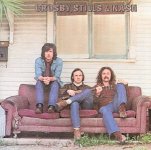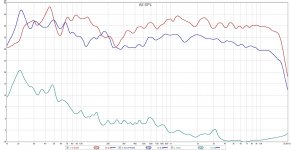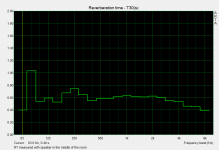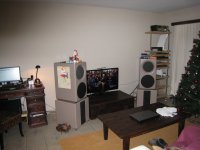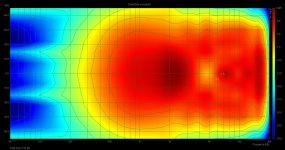I've been meaning to ask if there is an exception recording of say something by Stravinsky. I keep buy Classical CDs and they keep disappointing me that they are so badly recorded.
The Telarc Firebird was an audiophile standard for many years.
Stravinsky Firebird Suite Borodin Polovtsian Dance : Robert Shaw & Atlanta Symphony Orchestra And Chorus : Concord Music Group
I have this on SACD and it its very good.
Stravinsky Petrouchka The Firebird Suite Scherzo a : Paavo Jarvi & Cincinnati Symphony Orchestra : Concord Music Group
I don't have this one but Delos is usually pretty safe, probably an Eargle recording.
Stravinsky: The Rite of Spring; The Firebird Suite
Reviews for James DePreist
Regards,
David
Interestingly, on the Delos link, this came up Stravinsky: The Rite of Spring - Trans. for Solo Piano, which is my good friend. The performance is exceptional, but the recording ios botched. It clips in several spots.
Interestingly, on the Delos link, this came up Stravinsky: The Rite of Spring - Trans. for Solo Piano, which is my good friend. The performance is exceptional, but the recording ios botched. It clips in several spots.
Modern Pop must bring you to tears, for all the wrong reasons!
I have this recording of Rachmaninov's Symphony No.2 that is quite phenomenal. Unfortunately, it was a diy speaker contest test disc and I still don't know what the album is. TerryO here should know.
Thanks for the other references. In my short experience, well recorded classical has been hard to come by.
Thanks for the other references. In my short experience, well recorded classical has been hard to come by.
Last edited:
Have you tried Reference Recordings CDs or their HD files played from a computer? When their HDCDs are played back on players that decode HDCD or if decoded during a CD rip, the results are even better.Agreed. But it may well be beyond the capabilities of two channel. Making it the "standard" may force compromises on the "other" genres that don't really have all that much benefit to the classical genre because its just not possible to do.
I've been meaning to ask if there is an exception recording of say something by Stravinsky. I keep buy Classical CDs and they keep disappointing me that they are so badly recorded.
Just last week, I gave a small company a demo circuit for headphone stereo improvement. The evaluator listened to it listened to it and said that;s the answer to headphone playback. All I did was an educated guess what the headphone impedance compensation circuit should be like. I didn't even listen to it before I gave it to them. Same with speakers, you also have to smooth out the impedance as much as practical.
Mr Linkwitz is of course mainly into Classical music so If you want an easy reference point for reference quality recordings SL has his own ever growing list:
Music and sounds
Music and sounds
At RMAF 2008 I met a fellow who did his own recordings. His card said "Log Cabin Recordings". He was from Sausalito, CA. Brilliant stuff, all done with a single stereo mic. He seemed to be the king of mic placement. I wanted to buy some of his stuff, but was never able to get in touch with him. 🙁
His own "sound pictures" is quite revealing. In fact I'm going to try it out with headphones when things are setup.Mr Linkwitz is of course mainly into Classical music so If you want an easy reference point for reference quality recordings SL has his own ever growing list:
Music and sounds
His own "sound pictures" is quite revealing. In fact I'm going to try it out with headphones when things are setup.
Indeed, this is very suitable for a system test. Still, it is biased towards classical music.
I nominate Pink Floyd The Wall as a good example of a pre compress-the-hell-out-of-the-dynamic-range rock/pop CD, at least the release I have. Very high crest factors (average signal level is below -18dB FS) lots of punch but excellent sound quality. This album will sort the bookshelf speakers from the real ones 😉
The problem with recommending pop/rock CD releases is that they frequently get re-released, and every re-release seems to alter the mastering towards more and more compression, so there is no guarantee that later releases of the same album released in the 2000's are not compressed or have not had their tonal balance "tweaked".
Same problem with "Thriller" - the original CD version is great quality with no compression but more recent releases have added compression and limiting...
I was recently browsing the Simon & Garfunkel collection on iTunes and its discouraging just how different the tonal balance of the exact same song is on different "collections" CD's... on one "best of" album a certain song sounded just perfect, on another the treble was so cranked up it was uncomfortable to listen to... I sometimes wonder if some engineers are tone deaf 😀
Buyer beware when choosing which release of a song or album to get...
The problem with recommending pop/rock CD releases is that they frequently get re-released, and every re-release seems to alter the mastering towards more and more compression, so there is no guarantee that later releases of the same album released in the 2000's are not compressed or have not had their tonal balance "tweaked".
Same problem with "Thriller" - the original CD version is great quality with no compression but more recent releases have added compression and limiting...
I was recently browsing the Simon & Garfunkel collection on iTunes and its discouraging just how different the tonal balance of the exact same song is on different "collections" CD's... on one "best of" album a certain song sounded just perfect, on another the treble was so cranked up it was uncomfortable to listen to... I sometimes wonder if some engineers are tone deaf 😀
Buyer beware when choosing which release of a song or album to get...
Last edited:
Indeed. If I'm ever buying a song from iTunes and there are multiple versions of the same song from different albums or collections I now always audition the preview of every version critically on the stereo before choosing which to buy, rather than just playing it on a laptop and saying "yep, thats the right song" only to be disappointed by the quality later.Just like the old days when we sought out the best pressings of an LP.
Although I'd prefer to buy a CD version of an album I really like (and still often do) the problem is you can't audition it before purchase, and if its a classic like The Wall you really have no idea whether you're getting one that's faithful to the original or a re-released "tweaked" version. At least with iTunes previews you can try before you buy. (I'll take a well encoded 256kbit AAC original without dynamic range compression over a CD re-release with dynamic range compression any day)
For a good example of the same song being progressively further compressed on each re-release, check the waveform displays of "Black or White" on the top right of this article:
Loudness war - Wikipedia, the free encyclopedia
Disgraceful 🙁
Last edited:
A couple of years back I got to compare one of my reference tracks "Riders on the Storm" from my "The Doors Greatest Hits" double CD to an early pressing of the song on the "LA Woman" album. The CD wasn't as bad as I thought it would be. A little compressed, a little tweaked and EQ'd, but not bad. More "modern" and less relaxed than the LP version. Similar to the Beatles remasters.
The big shock was hearing Julie London on vinyl. Oooooh so much better than CD. I ran right out and bought some.
The big shock was hearing Julie London on vinyl. Oooooh so much better than CD. I ran right out and bought some.
Pretty late, but here is my in and out of phase measurement... Room is L-shaped with brick walls, tile floor and concrete ceiling. RT is around 0.6s. There is no room treatment, but any suggestions that are WAF friendly are more than welcome...
Edit: added polar responce also (remark: only from 0 to 45°, other angles I did not measure... Measured without sub and without gating inside)
Edit: added polar responce also (remark: only from 0 to 45°, other angles I did not measure... Measured without sub and without gating inside)
Attachments
Last edited:
Pretty late, but here is my in and out of phase measurement... Room is L-shaped with brick walls, tile floor and concrete ceiling. RT is around 0.6s. There is no room treatment, but any suggestions that are WAF friendly are more than welcome...
Nicely uniform through the upper range. A 0.6 RT is a little lively but the directivity of your horns looks like it balances it out nicely.
This is a point that I've tried to make in this thread: as much as we debate the merits of higher and lower directivity, the room has as much a contribution in the overall direct-to-reflected ratio we perceive.
You have a reverberent room and directional speakers, the next person may have a dead room with very wide angle dispersion speakers. You may both hear the same results from your system.
For WAF, I've hung a nice orriental rug on one wall, and we have heavy velour drapes for a second wall. Let her pick the colors.😉
David S.
Interesting point David. I think Earl mentioned a similar opinion on considering the room a couple of times in this thread. However, results in the two examples you mention may be similar but there might be a considerable difference in the level of early reflections.
Now that we're talking about it, the direct/reverberant ratio can be an important cue in distance perception, but I believe it has not really been considered in this thread yet (as opposed to discrete, early reflections). I'm interested in the opinion that others here have on the relevance of this measure. 🙂
Now that we're talking about it, the direct/reverberant ratio can be an important cue in distance perception, but I believe it has not really been considered in this thread yet (as opposed to discrete, early reflections). I'm interested in the opinion that others here have on the relevance of this measure. 🙂
I find my on-axis response has everything to do with how things sound but I cannot betray the power response or it falls apart. For example, I can change my listening axis and among other things for example, this will bring about an increase in the apparent treble (how it sounds) but will not change the weight (how it kind of feels) and in both cases it will have a sense of correctness. Undoing that and EQing this amount only on-axis instead will just make it wrong, bringing about sibilance.
It's like toast and jam I guess. The power response is the bread, a foundation...plain but weighty, and essential in the process. The on-axis response is the jam, thin...but tasty, and although it is optional, it's what this is all about.
I am dealing with a reflection based peak at the moment at 400Hz. If I defer to the correct power response (with its on-axis peak) it sounds coloured but at the same time it sounds strangely correct. If I EQ it to flat on axis (with a corresponding dip in the power response, it sounds uncoloured (a natural tone), but it sounds strangely thin and unsubstantial. It is causing me to question whether my need for directivity doesn't extend below the 500Hz which has been suggested.
It's like toast and jam I guess. The power response is the bread, a foundation...plain but weighty, and essential in the process. The on-axis response is the jam, thin...but tasty, and although it is optional, it's what this is all about.
I am dealing with a reflection based peak at the moment at 400Hz. If I defer to the correct power response (with its on-axis peak) it sounds coloured but at the same time it sounds strangely correct. If I EQ it to flat on axis (with a corresponding dip in the power response, it sounds uncoloured (a natural tone), but it sounds strangely thin and unsubstantial. It is causing me to question whether my need for directivity doesn't extend below the 500Hz which has been suggested.
- Status
- Not open for further replies.
- Home
- Loudspeakers
- Multi-Way
- What is the ideal directivity pattern for stereo speakers?
